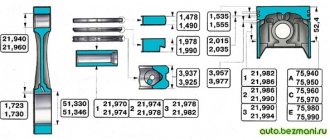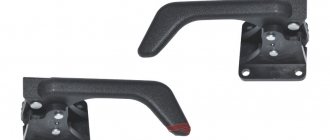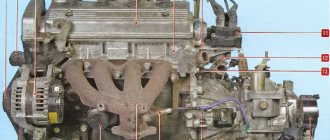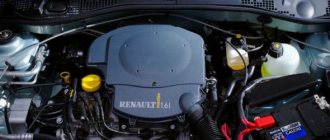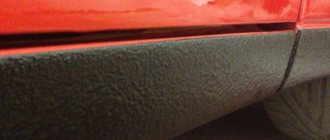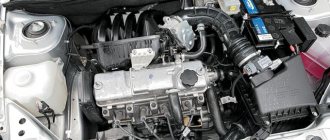Only in 2016, AvtoVAZ, for the first time in history, chose energy efficiency over gasoline savings, so the developers of the VAZ 21179 engine were faced with tasks in order of importance:
- achieve high torques, even at low speeds;
- increase power and volume;
- increase resource and use high-quality attachments.
ICE 21179
Already at 1000 rpm, the engine shows the torque developed at the peak of the capabilities of previous versions of the internal combustion engine, and its maximum is 170 Nm at 3750 rpm. Under the hoods of the X-Rays and West there is now 122 hp. With. in a 1.8 liter internal combustion engine. With the resource, everything is not easy due to an obvious flaw in the designers - the insufficient size of the groove inside the main bearings.
Engine characteristics 21179
Initially, the plant management set the task of increasing the volume, so a standard boost was used - maintaining the cylinder diameter, increasing the piston stroke. The power drive 21127 used as a basis bends the valve, so version 21179 inherited this defect along with a high-life Gates belt to provide at least some guarantees against timing belt breakage.
The engine diagram remains the same:
- transverse, front-wheel drive;
- camshafts located at the top, 4 valves per cylinder.
Motor parts 21179
The developers have already made tuning in the engine:
- adding piston stroke;
- increasing the diameter of the valve while reducing the thickness of its rod to 5 mm;
- vortex supply of the air mixture into the combustion chamber.
Even with increased oil consumption, the internal combustion engine consumes it within 200 ml/1000 km. The factory manual contains a description of all changes in the design and parameters of the power drive.
Design Features
Despite the fact that the motor is lighter than previous versions, it uses large quantities of attachments, so overhaul and even normal maintenance on your own is a difficult task.
For example, the manufacturer provides for fixing the camshafts and crankshaft with special devices. To install them, he recommends removing most of the overhead and intake tract. Likewise, upgrading to increase power is also difficult since there is no free space under the hood.
Intake manifold Motor Super
As a result, the technical characteristics of modification 21179 are as follows:
| Manufacturer | AvtoVAZ |
| Engine brand | 21179 |
| Years of production | 2016 – … |
| Volume | 1774 cm3 (1.8 l) |
| Power | 89.7 kW (122 hp) |
| Torque moment | 170 Nm (at 3750 rpm) |
| Weight | 99.3 kg |
| Compression ratio | 10,3 |
| Nutrition | injector |
| Motor type | in-line |
| Injection | distributed electronically controlled |
| Ignition | electronic contactless microprocessor |
| Number of cylinders | 4 |
| Location of the first cylinder | TVE |
| Number of valves on each cylinder | 4 |
| Cylinder head material | aluminum alloy |
| Intake manifold | plastic manufacturer Motor Super |
| An exhaust manifold | catalyst |
| Camshaft | 2 pcs., marks on pulleys are offset by 2 degrees |
| Cylinder block material | cast iron |
| Cylinder diameter | 82 mm |
| Pistons | lightweight, manufacturer Federal Mogul |
| Crankshaft | from 11183 |
| Piston stroke | 84 mm |
| Fuel | AI-92 |
| Environmental standards | Euro 5/6 |
| Fuel consumption | highway – 5.8 l/100 km combined cycle 6.8 l/100 km city – 8.6 l/100 km |
| Oil consumption | maximum 0.2 l/1000 km |
| What kind of oil to pour into the engine by viscosity | 0W30, 0W40, 5W30, 5W40, 10W30, 10W40, 15W40 |
| Which engine oil is best by manufacturer | Liqui Moly, LukOil, Rosneft, Mannol, Mobil, Castrol |
| Oil for 21129 according to composition | synthetics, semi-synthetics |
| Engine oil volume | 4.4 l |
| Operating temperature | 95° |
| ICE resource | declared 200,000 km real unknown |
| Adjustment of valves | hydraulic compensators |
| Cooling system | forced, antifreeze |
| Coolant volume | 7.8 l |
| water pump | with metal impeller GBM |
| Candles for 21129 | BCPR6ES from NGK or domestic AU17DVRM |
| Spark plug gap | 1.1 mm |
| Timing belt | Gates, width 22 mm, service life 200,000 km |
| Cylinder operating order | 1-3-4-2 |
| Air filter | Nitto, Knecht, Fram, WIX, Hengst |
| Oil filter | catalog number 90915-10001 replacement 90915-10003, with check valve |
| Flywheel | increased damper size |
| Flywheel mounting bolts | box MT – M10x1.25 mm, length 26 mm, groove 11 mm box AT – M10x1.25 mm, length 26 mm without groove |
| Valve stem seals | code 90913-02090 inlet light code 90913-02088 exhaust dark |
| Compression | from 13 bar, difference in adjacent cylinders maximum 1 bar |
| XX speed | 800 – 850 min-1 |
| Tightening force of threaded connections | spark plug – 31 – 39 Nm flywheel – 62 – 87 Nm clutch bolt – 19 – 30 Nm bearing cap – 68 – 84 Nm (main) and 43 – 53 (rod) cylinder head – three stages 20 Nm, 69 – 85 Nm + 90° + 90° |
This is the manufacturer’s second engine with a similar volume, but for the first time the cylinders were bored out, and here an integrated approach was used to improve the performance of the engines.
Problems
Not only reviews about the VAZ 21179 engine, but also its production cycle (it was produced in a very short time), indicate that this was not the most successful option for manufacturers. The main problems faced by owners are the following:
- Unfortunately, the power unit is characterized by increased consumption of lubricating fluid. There are quite a large number of opinions about the causes of oil burns. But most likely this is due to design features, since increased oil consumption can be overcome by boring the cylinders and achieving normal piston clearances.
- The oil pump in this internal combustion engine often jams, and the main reason that the pressure relief valve remains in the open position is the adhesion of combustion products on it. It is worth closely monitoring the lubricant pressure, since a drop in it can affect very rapid wear of the camshaft and crankshaft journals.
- There are also other breakdowns in the form of regular oil leaks from the camshaft plugs. Also, sometimes the fuel supply pipe can rub against the partition bracket, which can lead to a fire. The timing belt also often breaks.
Design nuances
The 21179 engine bears little resemblance to the basic version 21127, as both the design and appearance have changed:
- phasing of intake valves within ±30 degrees;
- hollow camshafts with cams using powder metallurgy;
- vortex air supply into the combustion chamber;
- cylinder cooling system (jacket);
- improved configuration and cylinder head gasket volumes;
- ShPG Federal Mogul;
- Korean pump;
- inclined drilling of oil channels in the crankshaft journals;
- polymer cylinder head cover and solid aluminum pan;
- flywheel for clutch 215 mm, which is recommended by the manufacturer.
Motor gaskets
ShPG from Federal Mogul
A distinctive feature of the ICE 21179 was a very complex and expensive overhaul, even when performed on its own in a garage.
Operating conditions and factors affecting oil consumption
Exceeding the engine fluid consumption rate should alert the car owner. Lubricant consumption may increase in engines with significant wear. In any case, engine oil consumption must be periodically monitored. Insufficient mixture in the lubrication system leads to malfunctions, which are usually followed by the need for expensive repairs.
Lubricant consumption depends on several aggregate indicators:
- characteristics of the condition of the internal combustion engine (this includes not only age, power, cylinder displacement and degree of wear, but also the climatic conditions in which it is operated, timely technical inspection and a number of other factors);
- filter condition (clogged or damaged will increase flow);
- type of internal combustion engine design (oil consumption depends on the type of fuel resource and the method of its supply);
- technical characteristics and quality indicators of motor fluid.
The reason for the high consumption of engine oil in the engine may be due to operating conditions, increased load, external unfavorable factors and excessive levels of lubricant in the system.
Pros and cons
The new power drive initially has a number of advantages:
- torque is increased, not only in the high speed range, but also at the bottom;
- oil pump performance has been doubled;
- camshafts are lighter, valve cross-section is increased;
- The displacement and engine power have changed significantly - 1.8 liters and 122 liters. pp., respectively;
- a phase distributor appeared on the intake camshaft;
- the intake and exhaust tracts have been improved, Euro-5 standards have been met;
- it is possible to finalize it to the Euro-6 protocol, planned for 2020.
Phase distributor
Exhaust tract
To replace the timing belt, it is necessary to remove half of the equipment under the hood. We come across defective valves from the German manufacturer Mahle, whose production facilities are actually located in China. Hence the increased oil consumption to 3 l/1000 km, then the cylinder head is replaced, which is very expensive (overhaul instead of maintenance).
The main bearing shells have a groove of less than 180 degrees; there are no counter grooves in the yokes. This single drawback is negated by the use of the latest higher-capacity oil pump, cooling channels between the cylinders and larger valve diameters.
Oil pump GMB
The use of high-quality parts from foreign manufacturers is not as clear as the designers intended:
- at any time after the European Union imposes sanctions against the Russian Federation, supplies may stop unilaterally;
- domestic industry is not yet able to provide such manufacturing precision;
- the engines will be equipped with a ShPG, low-quality timing belts and rollers, the service life will immediately decrease by half, that is, to 70 - 80 thousand kilometers.
Automatic tensioner
AvtoVAZ remains practically the only manufacturer in the world that, in principle, cannot provide the necessary precision in the manufacture of parts, which is why selective assembly is used on the assembly line, which indicates not advanced, but extremely poor technologies. It is easier for designers to “force the machine” to distinguish between the accuracy class markings of connecting rods and crankshaft main journals and bearings than to strictly adhere to one accuracy class, as in the entire civilized world.
Crankshaft 21179
As a result, the declared service life remains in question, since the lubricant used in the design of the main bearings will clearly be insufficient; scuffing of the crankshaft and overhaul are possible after 50,000 km.
Oil consumption standards after 2022
In February 2022, AvtoVAZ sent information letter No. 23-20 to the heads of the dealer network “On the appeal of consumers with the defect “increased oil consumption” of LADA car engines.” It states that when operating vehicles, consumers may complain of “blue smoke at the exit of the exhaust system, increased oil consumption.” During the warranty period, to assess the need for engine diagnostics, by analogy with the applicable f. Renault has established and included in the new Operating Manuals for LADA vehicles a control value for oil consumption, which is no more than 0.5 liters per 1000 km
vehicle mileage. There is also an addition to the actual oil consumption, depending on the influencing factors, recommendations to consumers on reducing oil consumption when operating vehicles.
At the same time, it is indicated that IP No. 62-12, No. 48-17 (discussed above) should be considered invalid.
Here's what was added to the car's owner's manual:
Actual oil consumption
. Oil consumption is provided for by the engine design and cannot be equal to zero, otherwise the engine will be destroyed. Oil is consumed primarily through piston rings and valve seals, the purpose of which is not an absolute seal, but to meter oil penetration to ensure lubrication. A small amount of oil is also consumed through the crankcase ventilation system. Operating oil consumption depends on many factors:
- compliance by the consumer with operating conditions during the vehicle break-in period and, accordingly, the quality of running-in of engine friction surfaces;
- viscosity-temperature properties of the oil used;
- quality of the oil used;
- frequency of oil changes;
- ambient temperature;
- the amount (level) of engine oil maintained by the owner;
- driving style of the car owner (engine operating modes);
- driving routes used by the owner.
Recommendations for reducing oil consumption
:
- Strictly follow the recommendations for running in the car and engine (see the subsection “Operating a new car” in the “Driving a car” section) to ensure optimal running-in of the cylinder-piston parts, the surface quality of which significantly affects oil consumption.
- Use high-quality fuel that ensures the safety of parts of the cylinder-piston group.
- Use high-quality motor oils for reliable lubrication, cooling and removal of natural wear products from friction surfaces without the formation of unnecessary deposits of sludge, varnish and carbon deposits.
- Follow recommendations to match the viscosity-temperature properties of the oil to environmental conditions to maintain optimal lubrication conditions.
- Maintain the oil level between the MIN and MAX marks.
- Observe the oil change intervals.
- Carry out engine maintenance regularly.
- Drive the vehicle at moderate engine speeds, with smooth acceleration, within the permitted speed limits. Because oil consumption is higher, the higher the load and engine speed.
- If possible, minimize the frequency of using the engine braking mode (driving with the accelerator pedal released and with the gearbox in low gear, when the wheels rotate the engine through the transmission).
- Choose rational routes that minimize the number of stops, starts, and accelerations.
In which cars is it present?
The first in the manufacturer’s line, the 1.8 liter engine 21179 is installed in only two brands of cars from the AvtoVAZ manufacturer:
- Lada Vesta - since 2016, five-door, five-seater station wagon or sedan;
- Lada X-Ray - since 2016, five-seater, five-door hatchback.
This is due to the fact that the engine characteristics are more tailored to French gearboxes, which are not yet used on other manufacturer’s cars. In the future, equipment for Grant, Kalina-2, Largus and Lada 4x4 NG vehicles will be available.
AMT robot box for X Rey
Oil consumption standards after 2022
In February 2022, AvtoVAZ sent information letter No. 23-20 to the heads of the dealer network “On the appeal of consumers with the defect “increased oil consumption” of LADA car engines.” It states that when operating vehicles, consumers may complain of “blue smoke at the exit of the exhaust system, increased oil consumption.” During the warranty period, to assess the need for engine diagnostics, by analogy with the applicable f. Renault has established and included in the new Operating Manuals for LADA vehicles a control value for oil consumption, which is no more than 0.5 liters per 1000 km
vehicle mileage. There is also an addition to the actual oil consumption, depending on the influencing factors, recommendations to consumers on reducing oil consumption when operating vehicles.
At the same time, it is indicated that IP No. 62-12, No. 48-17 (discussed above) should be considered invalid.
Here's what was added to the car's owner's manual:
Actual oil consumption
. Oil consumption is provided for by the engine design and cannot be equal to zero, otherwise the engine will be destroyed. Oil is consumed primarily through piston rings and valve seals, the purpose of which is not an absolute seal, but to meter oil penetration to ensure lubrication. A small amount of oil is also consumed through the crankcase ventilation system. Operating oil consumption depends on many factors:
- compliance by the consumer with operating conditions during the vehicle break-in period and, accordingly, the quality of running-in of engine friction surfaces;
- viscosity-temperature properties of the oil used;
- quality of the oil used;
- frequency of oil changes;
- ambient temperature;
- the amount (level) of engine oil maintained by the owner;
- driving style of the car owner (engine operating modes);
- driving routes used by the owner.
Recommendations for reducing oil consumption
:
- Strictly follow the recommendations for running in the car and engine (see the subsection “Operating a new car” in the “Driving a car” section) to ensure optimal running-in of the cylinder-piston parts, the surface quality of which significantly affects oil consumption.
- Use high-quality fuel that ensures the safety of parts of the cylinder-piston group.
- Use high-quality motor oils for reliable lubrication, cooling and removal of natural wear products from friction surfaces without the formation of unnecessary deposits of sludge, varnish and carbon deposits.
- Follow recommendations to match the viscosity-temperature properties of the oil to environmental conditions to maintain optimal lubrication conditions.
- Maintain the oil level between the MIN and MAX marks.
- Observe the oil change intervals.
- Carry out engine maintenance regularly.
- Drive the vehicle at moderate engine speeds, with smooth acceleration, within the permitted speed limits. Because oil consumption is higher, the higher the load and engine speed.
- If possible, minimize the frequency of using the engine braking mode (driving with the accelerator pedal released and with the gearbox in low gear, when the wheels rotate the engine through the transmission).
- Choose rational routes that minimize the number of stops, starts, and accelerations.
Maintenance
The actual life of the internal combustion engine is still unknown due to the short service life of the first cars that rolled off the assembly line in 2016. However, to increase it, engine 21179 should be serviced according to the regulations below:
- 10,000 km means changing the filter/oil;
- twice as long, the alternator belt runs 30,000 km;
- after 45,000 km, change hoses/fittings and antifreeze;
- spark plugs and batteries are enough for 60,000 km;
- About 180,000 the original timing belt passes.
For 2022, the internal combustion engine device is considered the most advanced in the AvtoVAZ manufacturer’s line. In practice, his project had been considered since 2006, but was constantly postponed until the technical, economic and market situation in the Russian Federation finally developed favorably. That is, AvtoVAZ in this project prioritized the power output of the engine, and not economical fuel consumption, as was usually the case before.
Oil sump volume
This point will be useful for those who are going to change the engine oil. With different transmissions, the volume of oil poured into the engine is also different.
VAZ 21129 manual transmission Renault (cast crankcase) = 4.4l
VAZ 21129 robot (stamped crater) = 3.2 l
The engine resource is 200 km. But in practice, you need to monitor the condition of the roller, pump and timing belt, because if individual valve elements jam, they will meet the piston group, and then both will come to an end. In addition, during the impact of these elements, it is not uncommon that the crankshaft bends slightly. You can drive with such a crankshaft, but there will be huge oil consumption.
Causes of problems and solutions
In the very first Vesta and X-Ray models that came off the assembly line in 2016, motor 21179 has been in use for less than two years. At this stage, only two problems have been identified that are unique to this modification:
- increased oil consumption - insufficient quality of valves made in China, replacement with original Mahle parts is necessary;
- wear of the crankshaft and liners - poor lubrication due to manufacturer defects; replacement of the original yokes with versions of previous engines with a small groove and main bearing liners with a 180-degree groove is required.
Fuel rail
Other malfunctions are similar to 16 valve internal combustion engines of previous generations.
Oil consumption standards after 2022
In February 2022, AvtoVAZ sent information letter No. 23-20 to the heads of the dealer network “On the appeal of consumers with the defect “increased oil consumption” of LADA car engines.” It states that when operating vehicles, consumers may complain of “blue smoke at the exit of the exhaust system, increased oil consumption.” During the warranty period, to assess the need for engine diagnostics, by analogy with the applicable f. Renault has established and included in the new Operating Manuals for LADA vehicles a control value for oil consumption, which is no more than 0.5 liters per 1000 km
vehicle mileage. There is also an addition to the actual oil consumption, depending on the influencing factors, recommendations to consumers on reducing oil consumption when operating vehicles.
At the same time, it is indicated that IP No. 62-12, No. 48-17 (discussed above) should be considered invalid.
Here's what was added to the car's owner's manual:
Actual oil consumption
. Oil consumption is provided for by the engine design and cannot be equal to zero, otherwise the engine will be destroyed. Oil is consumed primarily through piston rings and valve seals, the purpose of which is not an absolute seal, but to meter oil penetration to ensure lubrication. A small amount of oil is also consumed through the crankcase ventilation system. Operating oil consumption depends on many factors:
- compliance by the consumer with operating conditions during the vehicle break-in period and, accordingly, the quality of running-in of engine friction surfaces;
- viscosity-temperature properties of the oil used;
- quality of the oil used;
- frequency of oil changes;
- ambient temperature;
- the amount (level) of engine oil maintained by the owner;
- driving style of the car owner (engine operating modes);
- driving routes used by the owner.
Recommendations for reducing oil consumption
:
- Strictly follow the recommendations for running in the car and engine (see the subsection “Operating a new car” in the “Driving a car” section) to ensure optimal running-in of the cylinder-piston parts, the surface quality of which significantly affects oil consumption.
- Use high-quality fuel that ensures the safety of parts of the cylinder-piston group.
- Use high-quality motor oils for reliable lubrication, cooling and removal of natural wear products from friction surfaces without the formation of unnecessary deposits of sludge, varnish and carbon deposits.
- Follow recommendations to match the viscosity-temperature properties of the oil to environmental conditions to maintain optimal lubrication conditions.
- Maintain the oil level between the MIN and MAX marks.
- Observe the oil change intervals.
- Carry out engine maintenance regularly.
- Drive the vehicle at moderate engine speeds, with smooth acceleration, within the permitted speed limits. Because oil consumption is higher, the higher the load and engine speed.
- If possible, minimize the frequency of using the engine braking mode (driving with the accelerator pedal released and with the gearbox in low gear, when the wheels rotate the engine through the transmission).
- Choose rational routes that minimize the number of stops, starts, and accelerations.
Engine tuning
As standard for the AvtoVAZ manufacturer, engine 21179 has a potential of at least 150 hp. With. However, tuning is complicated by the following factors:
- M86 control unit - it is very difficult to change the internal combustion engine settings online;
- exhaust tract - the diameter of the manifold is narrowed for Euro-5 standards, it is almost impossible to install a “spider”.
Electronic throttle
Motor 21179 is initially already a factory tuning of versions 21127 and 21129, so without the ability to configure controllers, rarely anyone manages to upgrade it on their own.
Thus, the 21179 engine for 2022 is the best version of the 16-valve power drive with a DOHC two-shaft design. All components have undergone changes, with the exception of control controllers and spark plugs; spare parts from foreign companies are widely used, which is not entirely correct at the time of EU sanctions against Russia.
If you have any questions, leave them in the comments below the article. We or our visitors will be happy to answer them
History of origin
Motor 21179 was already in the minds of the engineer much earlier than you can imagine. Even at the end of the USSR, developers began to think about the Lada C project and its power units. Even then, engineers “knew” this motor by its features and power characteristics. But the difficult economic situation of that time and the collapse of the USSR forced the engineers to completely forget the Lada-Ts project.
And now, after a long time, when Boo Anderson comes to the post of general manager of AvtoVAZ, the project is raised and developed again.
The main task was to create an engine with good low-end torque, which AvtoVAZ lacked for a confident, comfortable ride. “Tractor” 8-cl engines have long since become obsolete, but the new 16-cl engines had a more “sporty” character. The situation was corrected by the then 21127 engine, now 21129, which is installed on Vesta, Xray, and other AvtoVAZ models. Due to the intake receiver with variable geometry installed on it, the torque from the bottom began much earlier, unlike the Prioromotor (21126), and its shelf was much further, right up to the cutoff. But with the start of production of a sedan with a larger mass - the Vesta, and the Xray hatchback - the need for low-end engines reappeared.
The engine was run in and tested for a long time. As a result, during the testing process it turned out that the rings were already stuck at 4t.km., as a result, the heat zone was increased and the problem disappeared.
Nissan HR16DE engine with 110 hp power. It copes well with its task on front-wheel drive. But if you have all-wheel drive, it will strain, get hot, eat a lot and not drive.
Another factor in the creation of the 21179 motor is economics and politics. Because the Nissan engine, although it is assembled here, still belongs to Nissan. And in the event of an unfavorable economic situation, an increase in exchange rates, the cost of its production and sale may simply be unprofitable.
Start of production of motor 21179
Back in 2014, there were rumors about the possible production of a 1.8 liter engine with phase shifters. And yet it became a reality. Previously, OPP and its subsidiary Super-Auto were already engaged in the construction and installation of a 1.8 liter engine with index 21128, which was installed in Priora Sport. But that engine did not have a special resource.
Match pistons to cylinders
Measure the diameters of the cylinders and pistons in accordance with clause 4 of this TI and calculate the gap between the cylinder and the piston.
The calculated gap for new parts should be 0.03...0.05 mm. The maximum permissible gap when parts are worn is 0.1 mm. If the gap is more than 0.1 mm, the cylinder block must be repaired.
The piston class must correspond to the cylinder class. Marking of pistons and cylinder classes is applied in accordance with clause 4 of this TI.
Match the pistons to the cylinders, ensuring a gap of no more than 0.05 mm, in accordance with Table 8.
| Cylinder size, mm | Designation | Class | Post-honing cylinder diameter, mm | Piston diameter, mm |
| Standard82.0 | 21177-1004015-00 | A | 82,00…82,01 | 81,96…81,97 |
| 21177-1004015-01 | B | 82,01…82,02 | 81,97…81,98 | |
| 21177-1004015-02 | C | 82,02…82,03 | 81,98…81,99 | |
| Repair82.5 | 21177-1004015-30 | A+0.5 | 82,50…82,51 | 82,46…82,47 |
| 21177-1004015-31 | B+0.5 | 82,51…82,52 | 82,47…82,48 | |
| 21177-1004015-32 | C+0.5 | 82,52…82,53 | 82,48…82,49 |
Check the fit of the piston pins in the bores of the piston bosses. The piston pin, lubricated with engine oil, should enter the piston bore when pressed by the thumb and smoothly come out of the piston boss holes under its own weight, while in a vertical position, as shown in Figure 48. If application is required to remove the piston pin from the piston boss holes additional effort, replace the mating parts.
Unit from Nissan
The cylinder block has two camshafts and four valves per cylinder. The camshafts are driven by a silent chain with an automatic tensioner, which is designed for the entire service life of the engine.
Thermal clearances in the valve drive are regulated by selecting pushers (there are no hydraulic compensators). The oil pump is located at the top of the engine sump and is driven by a chain. The main and additional catalytic converters are located in the exhaust pipe.
The HR16DE/H4M engine is equipped with an automatic variable valve timing system, which improves the filling of the engine cylinders in all operating modes. To do this, phase regulators rotate the sprockets of the intake camshafts relative to the shafts themselves; they are controlled by a hydraulic drive, which uses the oil pressure of the engine lubrication system.
Auxiliary units (generator and cooling system pump, air conditioning compressor) are driven by a serpentine belt. Two injectors are installed on each cylinder, fuel economy has increased, power has increased slightly, and idle speed has decreased.

